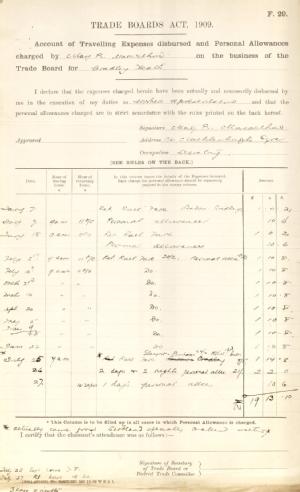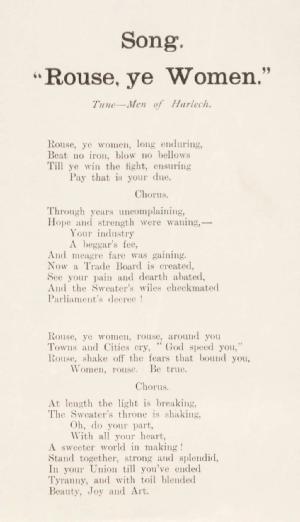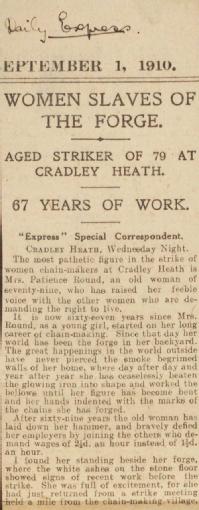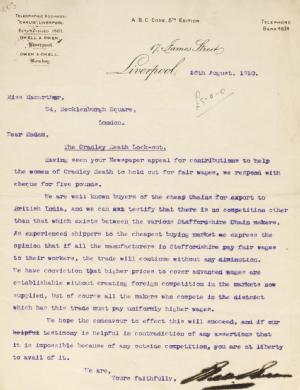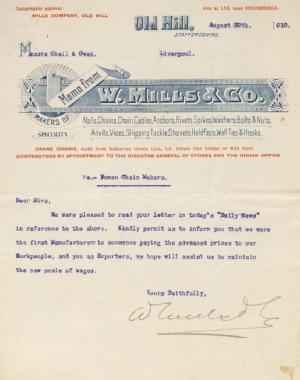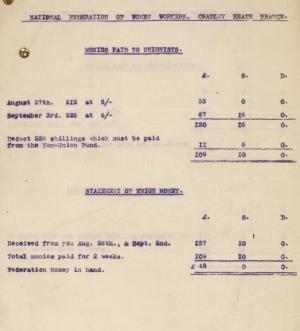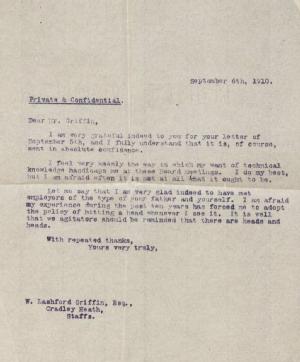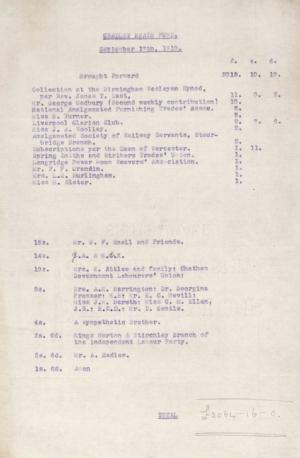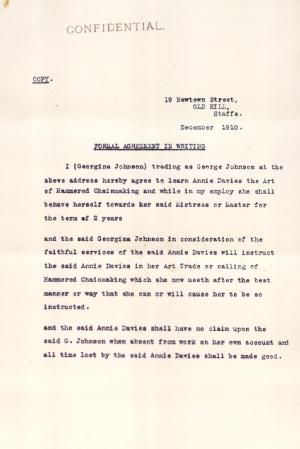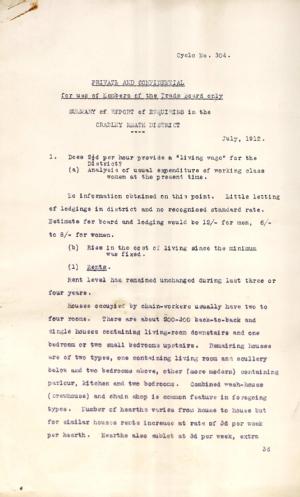"Rouse, Ye Women": The Cradley Heath Chain Makers' Strike, 1910
During the 19th century the Black Country, in particular the Cradley Heath area, became the centre for chain making in Britain. Heavy to medium chains were produced by men in factories, however the smaller chains (often known as 'hand-hammered' or 'country-work' chains) were often hand-worked by women or children in small cramped forges in outbuildings next to the home. The work was hot, physically demanding and poorly paid. Like other homeworking, chainmaking was an example of a "sweated" trade, where workers (often women) were paid a pittance to produce cheap goods at home.
At the start of the 20th century the campaign to end the exploitation of "sweated" labour gained increasing popular support. In 1909 the Liberal government passed the Trade Boards Act to set up regulatory boards to establish and enforce minimum rates of pay for workers in four of the most exploited industries - chain-making, box-making, lace-making and the production of ready-made clothing. In the Spring of 1910, the Chain Trade Board announced a minimum wage for hand-hammered chain-workers of two and a half pence an hour - for many women this was nearly double the existing rate. At the end of the Trade Board's consultation period in August 1910, many employers refused to pay the increase. In response, the women's union, the National Federation of Women Workers (NFWW), called a strike.
The strike lasted 10 weeks and attracted immense popular support from all sections of society - nearly £4,000 of donations were received by the end of the dispute from individual workers, trade unions, politicians, members of the aristocracy, business community and the clergy. The founder of the NFWW, Mary Macarthur, used mass meetings and the media - including the new medium of cinema - to bring the situation of the striking women to a wider audience and the strike became an international cause célèbre. Within a month 60% of employers had signed the 'White List' and agreed to pay the minimum rate, the dispute finally ended on 22 October when the last employer signed the list.
More documents relating to the Cradley Heath chainmakers are available online as part of our 'Work in the 'sweated' trades' digitisation projectLink opens in a new window.
"Sweated industries", 1906
Photograph of a Cradley Heath street, circa 1906, showing women standing in the doorways of their chainmaking workshops. This is one of a series of photographs of different trades which were commissioned for the handbook of the 'Sweated Industries' exhibition of 1906, part of the anti-'sweated labour' campaign of the Daily News. All illustrations from the handbook (including more Cradley Heath images) can be seen elsewhere on our websiteLink opens in a new window.
Document reference: MSS.15X/1/68/2.
"A general meeting will be held", 1910
Leaflet advertising a general meeting of the Cradley Heath and District Branch of the National Federation of Women Workers. It asks "all female workers engaged in the Hammered Branch of the Chain Trade" to observe the afternoon of Monday 11th April 1910 as a half-day holiday, to hear a report on the Trade Boards' Bill and its effects on the chain trade. Speakers at the meeting included the trade unionists Mary Macarthur and Thomas Sitch, and Mr J.J. Mallon, President of the Anti Sweating League.
Document reference: MSS.292C/239.08/3.
Rough copy of notes on visit to Cradley Heath, 1910
The four pages of notes include information on the approximate number of employers and employed chain makers (male and female) in the area, the attitudes of local employers to the Trade Boards, information about possible competition elsewhere in the UK and overseas, the question of mechanisation, and the prospects of minimum rates fixed by a Trade Board. It also suggests that the inclusion of the whole trade, rather than just the outworkers, would "deprive Miss Gore Booth, and people like her, of any ground for interference" - a likely reference to the suffragist Eva Gore-Booth.
Document reference: MSS.292C/239.08/3.
'Minimum rates in the hand-hammered chain trade', May 1910
Employers were required by law to post up copies of this notice, issued by the Chain Trade Board, in every factory, workshop or other place used for outwork. Objections to the proposed new rates had to be lodged within 3 months (by 16 August 1910).
Document reference: MSS.292C/239.08/3.
Summary of evidence submitted to the Chain Trade Board, 15 July 1910
The evidence relates to the work and conditions of two teenage apprentices, identified as "Miss A" and "Miss B", and the situation of "Mrs C", who ran a four hearth workshop and had seven children making chain. Two of the four pages are shown here.
Document reference: MSS.292C/239.08/3.
Notes about the rates paid to individual chain makers in Cradley Heath, [1910]
The notes record the rates paid to different chain makers for their work, the quantity of chain that they produce each week, and the difference between their current weekly earnings and the amount that they would get under the proposed rates of the new Trade Board. The examples shown here relate to Mrs Martha Grosvenor of Little Hill, Cradley, and Miss Tromans of Plants Green.
Document reference: MSS.292C/239.08/3.
A trade unionist's travel expenses, 1910
Account of travelling expenses incurred by Mary Macarthur, on the business of the Trade Board for Cradley Heath between January-June 1910. The accompanying letterLink opens in a new window to the Office of Trade Boards includes comments by Mary Macarthur about the "invidious distinction" between employers' and workers' representatives on the Trade Board (for example, workers' representatives can only claim for third class train travel, whilst employers' representatives travel in more comfort).
Document reference: MSS.292C/239.08/2.
Song, "Rouse ye Women", [1910]
Lyrics to be sung to the tune of 'Men of Harlech'. The song attacks the system of sweated labour and praises united action through the trade union and the formation of the Trade Board by Act of Parliament. The first verse entreats the "long enduring" women workers to "Beat no iron, blow no bellows Till ye win the fight, ensuring Pay that is your due."
Document reference: MSS.292C/239.08/3.
'Women slaves of the forge', 1 September 1910
Daily Express article about Mrs Patience Round, an "aged striker of 79", and one of 12 striking chainmakers over the age of 70. The report concentrates on Mrs Round's limited horizons, having "never in her life stepped across the outskirts of Cradley Heath", as well as her domestic situation - combining work from dawn to dusk with care of her crippled husband. She describes the strike as "the week of my life", and is quoted as saying that "these are wonderful times... I never thought that I should live to assert the rights of women".
Document reference: MSS.292C/239.08/3.
Letter of support from Okell & Owen to Mary Macarthur, 26 August 1910
Okell & Owen of Liverpool exported cheap chains of the type produced by the workers of Cradley Heath to India. The firm were strong supporters of the striking women, and sent a contribution of £5 towards the strike fund. They argued "that if all the manufacturers in Staffordshire pay fair wages to their workers, the trade will continue without any diminution".
Document reference: MSS.292C/239.08/3.
Manufacturers' assurances regarding the new rates of wages, August 1910
The exporter Okell & Owen of Liverpool asked manufacturers to provide assurances that the set wages would be paid to their workers. These responses are from the firms of Joseph Williams & Sons, William Bannister & Co. and W. Mills & Co., and were forwarded on to Mary Macarthur. Macarthur, in reply, thanked Okell & Owen for their "attitude throughout this trouble [which] has been of incalculable help to the women".
Document reference: MSS.292C/239.08/3.
Account of money paid to union members in the first two weeks of the strike, 1910
The money was paid out by the Cradley Heath branch of the National Federation of Women Workers. In the first week of the strike 212 union members and 202 non-members received 5/- and 2/6 respectively, by the second week numbers supported by the union had risen to 226 members and 430 non-members.
Document reference: MSS.292C/239.08/3.
Copy letter from Mary Macarthur to W. Lashford Griffin esq., 6 September 1910
Mr Griffin was a Cradley Heath chain manufacturer who gave confidential advice and technical assistance to Mary Macarthur. This letter thanks him for his help, and says that "I am afraid my experience during the past ten years has forced me to adopt the policy of hitting a head whenever I see it. It is well that we agitators should be reminded that there are heads and heads". All that remains of three out of four of Mr Griffin's letters are the letter-headings or signature - the contents have been snipped out.
Document reference: MSS.292C/239.08/3.
Account of the Cradley Heath Fund at 17 September 1910
Recent contributors included George Cadbury (owner of the Birmingham chocolate firm), members of Liverpool Clarion Cycling Club, the congregation of the Birmingham Wesleyan Synod, various national trade unions and local union branches, and, intriguingly, "Mrs E. Attlee and family" (conceivably Ellen Attlee, the mother of the future Prime Minister Clement Attlee). The strike fund had by this point reached the huge total of £2064 and 16 shillings. It would nearly double by the end of the strike.
Document reference: MSS.292C/239.08/3.
Applicants for "learners' certificates", December 1910
Examples of the new 2 year apprenticeship agreements were forwarded to the Chain Trade Board. The documents shown here are a summary of the particulars given by applicants for a learner's certificate, and a copy of the agreement of Annie Davies (aged 16), apprenticed to Georgina Johnson (trading as George Johnson).
Document reference: MSS.292C/239.08/1.
Summary of report of enquiries in the Cradley Heath district, July 1912
The nine page report enquires into whether, two years on, the minimum wage set by the Trade Board provides a "living wage" for the women workers of Cradley Heath. It looks at housing, food prices, rates of pay for women in other local industries, and the impact of competition from overseas manufacturers and machine-made chain.
Document reference: MSS.292C/239.08/1.

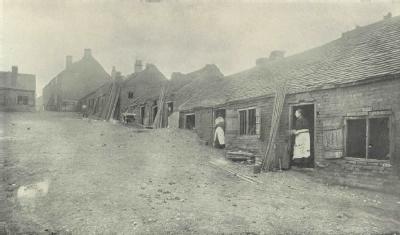
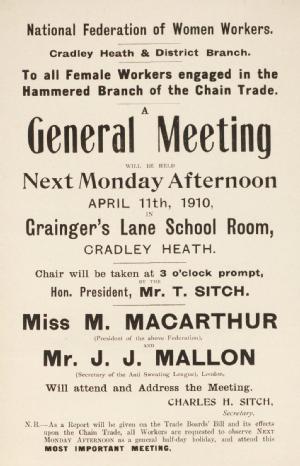
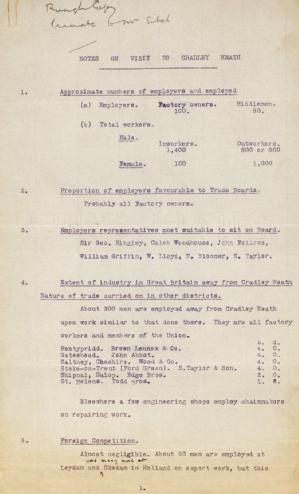
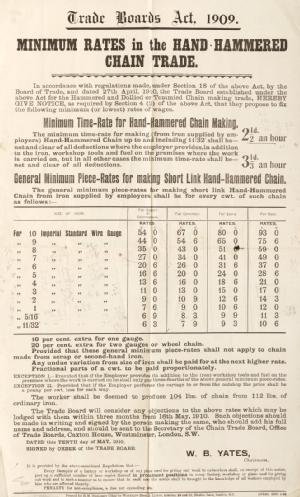
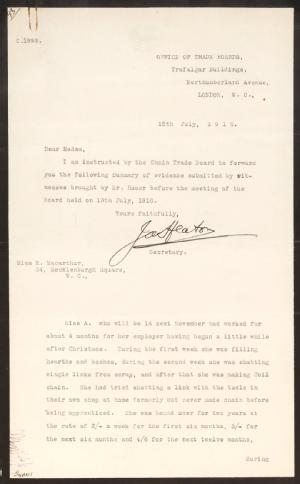
![Notes about the rates paid to individual chain makers in Cradley Heath, [1910]](3_0010.jpg?maxWidth=300)
